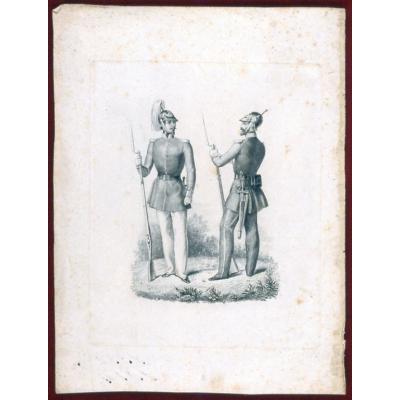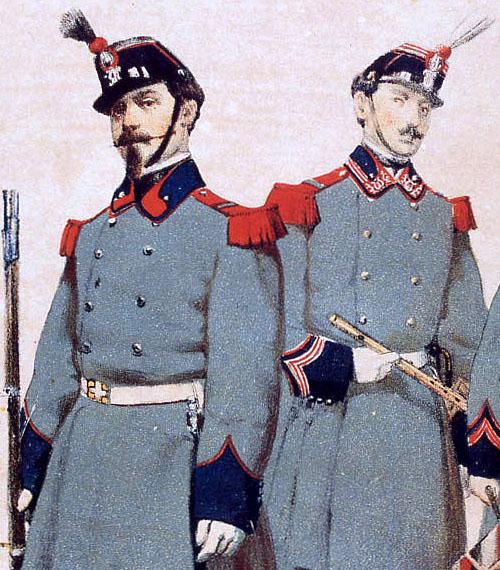Schede
The National Guard is institutionalized for the first time in France in 1791, in order to keep the public order and to protect the national territory from external aggressions; it represents one of the first realizations of the principles of the French Revolution: we might say, by quoting Umberto Marcelli, that it constitutes a basic moment within the process of transformation of the (subject/subordinate) into citizen: this latter, wearing a uniform, becomes the most concrete expression of the principle of (popular sovereignty).
The organization of these troops and the principle on which they are based spread very soon also in Italy, in the regions united into (Giacobine) Republics, in Tuscany and in the Papal States. In Bologna, the first divisions are created after Napoleon Bonaparte’s troops entered, on June 18, 1796: the city gains a new nominal independence and the Bolognese (giacobini) replace the “birri”, who depended upon the Senate, with a Civic Guard similar to the French one; this will soon become a National Guard after the constitution of the Cispadana Republic. The city is divided into 4 cantons, each one has two battalions made up of citizens aged between 18 and 50; the guard, divided into sedentary and mobile units for the city and the country service, gets into the Cisalpina Republic, then Italian and, finally, Republic of the Italic Kingdom. It’s the Restoration, setting anew the Papal States dominance in Bologna, that brings this first experience to a halt; the Guards are spread almost everywhere, yet ready to reorganize themselves in the most favourable times: in the short period of the Governo Provvisorio of the Province Unite Italiane, come after the riots of 1831, in fact, a Provincial Guard was created, called National and structured on the French period model (February 4, 1831). After the Austrians got into Bologna, March 21, the Guard is disarmed and split up; however, it will be re-enabled and abolished several times during the Thirties of the IX century. In July 1847, Pio IX allows the constitution of one Civic Guard in all the Papal States: all the citizens who followed the (mazziniana) current didn’t hesitate to consider it as the (prologue/preface) of a city army bound to gain Italy’s independence. The institution becomes general in all the states of the paeninsula, allowed by the sovereigns themselves, interested to block the revolutionary forces, that in these years have to cope with patriottical movements and requests of a more democratic society, coming from every part of Europe.
In 1848 the riot spreads all over the Italian states; Bologna becomes the centre where volunteers pass and are subdivided into other unities, directing towards the Po and meant to free the North of Italy from the foreigners. The volunteers unities’contribute vanishes, due to the lacking discipline, scarse coordination and equipment; the sad ending of the military actions makes them return to the city, where some battalions, together with (citizens), succeed in push away the Austrian troops in the August 8, 1848 battle. After the advent of the Roman Republic (February 9, 1849), the Civic Guard turns into the National Guard and is again divided into mobile and sedentary; troops coming from Bologna, as the First Battalion of National Guards under the command of Carlo Berti Pichat, are directed to Rome to resist to the attacks by the French, who wanted to (restore the Papal authority). Bologna, invaded and attacked by the Austrians, is forced to be submitted on May 16, 1849, after a week of intense gun firings. The Austrians set themselves in the city, starting a strict military occupation, that will finish only in 1859; the National Guard splits up. The departure of the Austrian troops and the end of the Papal domination (June 12, 1859) lead to the creation of a temporary government, soon followed by the sending of commissioner Leonetto Cipriani by the Piedmontese government; he will be succeeded by Luigi Carlo Farini, who rules till the plebiscite for the (annexation) to the Savoyard Kingdom, on March 11 and 12, 1860. Since June 1859, a (Guardia Provvisoria) is institutionalized in the city of Bologna, commanded by count Angelo Tattini; on July 20, Cipriani reinstitutes the National Guard, in order to both keep public safety and block, at the same time, the enthusiasm of the several Garibaldi’s fellows. But now the city troops (reconstitute everywhere) and bring a valid help to Garibaldi’s army to speed up the fall of Borboni’s domination. The institution is extended throughout all the Kingdom by the king’s decreet of April 4, 1861; it will be completely abolished in 1877, as a consequence of the radical transformation of the armed forces (Ricotti Law, 1871).






